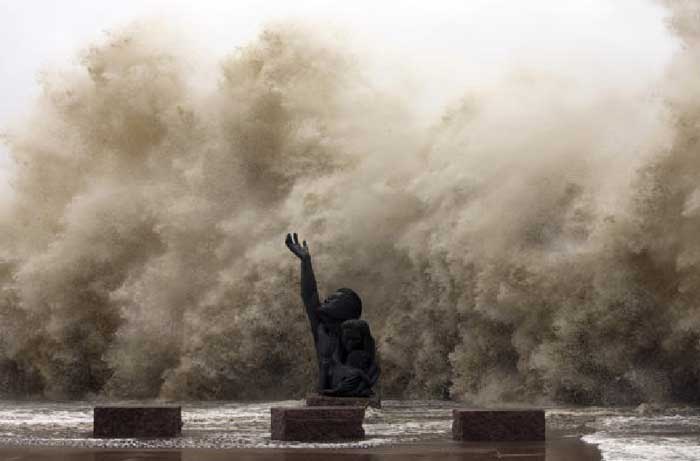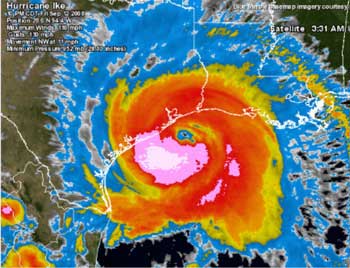By Steve Nerheim
As the USCG participates in the current challenging Gulf oil spill crisis, the danger of the tropical storm season coming upon us reminds us that crises can be telescoped. In this two part article by Steve Nerheim, the USCG approach to partnering in crisis management is analyzed from the vantage point of dealing with Hurricane Ike in 2008. Steve Nerheim has been Director of VTS Houston/Galveston and a member of the Greater Galveston Bay Port Coordination Team since 2005. His previous experience was as a U.S. Navy Surface Warfare Officer, principally in Destroyers. While on active duty he was additionally qualified and designated as an Underwater Warfare Specialist and a Joint Specialty Officer.
***
“Houston, we’ve had a problem.”
When astronaut James Lovell, Jr. spoke those words in April 1970 the Nation’s attention quickly focused upon the plight of Apollo-13 and its three man crew. Teams of NASA specialists and subject matter experts worked around the clock to assist the endangered astronauts in effecting a safe return to Earth. This is a great story of successful teamwork in defiance of all odds, and deserves remembering and retelling whether you recall the actual events or know the story from Ron Howard’s splendid film.
When Hurricane Ike roared ashore in southeast Texas in September 2008 it carried a fifteen foot storm surge and 100 MPH winds into one of the Nation’s busiest ports and largest petrochemical complex, disrupted regional infrastructure, decimated Galveston Island, the Bolivar Peninsula and other low lying areas, damaged or destroyed 58% of the aids to navigation along the Houston Ship Channel, filled a major stretch of the Gulf Intracoastal Canal with debris and shoals, damaged or destroyed several key Coast Guard facilities, and created over two billion dollars in economic impact to the major ports of the Sector Houston-Galveston AOR.

Houston had a problem. But it also had a solution.
Origin and maturation of the Port Coordination Team
Houston-Galveston’s Port Coordination team has its roots in the Port Emergency Committee (PEC) established following the December 21, 1992 collision between UTV Freemont and M/V Jurai Delmantinac. As originally constituted the PEC included industry representatives from the West Gulf Maritime Association, local Pilot’s Associations, American Waterways Operators/ Texas Waterways Operators, oil refiners, chemical refiners, Port Authorities, and liquid terminals in addition to the USCG and Army Corps of Engineers. The PEC expanded over time to include local government offices of emergency management and a broader cross-section of industry, and served the USCG and maritime stakeholders well. Despite its effectiveness, like many growing committees, it was becoming unwieldy.
Then-Commander Tom Marian, the penultimate Commanding Officer of Vessel Traffic Service Houston/Galveston, gave the Port Coordination Team its present form and function by capturing, formalizing, and documenting procedures in a “PCT Protocol.” Commander Marian’s protocol, developed and refined between 2002 and 2005, was originally oriented upon post-September 11 port security issues to establishing effective procedures for setting MARSEC 2 and 3 conditions. The PCT’s expanded application was “test driven” during a challenging 2003-04 fog season and the Christmas Eve 2003 MARSEC 2 surge ops on the HSC. These test-drives validated many concepts and proved the PCT’s utility in managing the resumption of commerce within the MTS following a prolonged closure or significant disruption. That experience also contributed to working out procedural “bugs” and to fine tuning the team’s composition. A number of passionate discussions on team membership/composition ensued, but in the end it was recognized that a town hall meeting approach, open to the entire general stakeholder community, would be unworkable. This led to a representative rather that democratic approach and a compact, cohesive Port Coordination Team made up of one delegate from each of our several port stakeholder constituencies.
The Port Coordination Team continued to evolve, grow, and mature through experience with fog closures and heavy weather disruptions, building habitual relationships and deepening the mutual trust and confidence between and among participants along the way. Importantly, the team’s personification of collaborative interdependence and its well-deserved reputation for success ensured that it held the complete trust and garnered the full support of a succession Sector Commanders and Captains of the Port. That trust and support was essential when the PCT faced its sternest test to date – Hurricane Ike.
PCT Concept of Operations
The mature PCT includes representatives of the entire spectrum of local martime interests and includes:
- Port of Houston Authority
- Port of Texas City
- Port of Galveston
- Port of Freeport
- Offshore Port/Gulfport (Lightering)
- Gulf Intercoastal Canal Association (Towing)
- West Gulf Maritime Association
- Houston Pilots
- Galveston-Texas City Pilots
- Brazos (Freeport) Pilots
- Oil Refiners
- Oil Terminals
- Chemical Carriers
- Chemical Facilities
- Non-VTS users (recreational/fishing)
- Harbor Tugs
- NOAA (Navigational Response Team)
- NOAA (National Weather Service)
- Army Corps of Engineers
- USCG Waterways Management (Sector and MSU)
- USCG Vessel Traffic Service
- USCG Sector Commander (or representative)
In heavy weather situations, the PCT does not work alone in restoring commerce to the MTS. It is closely partnered with, and coordinates closely and effectively with, the Texas Joint Hurricane Response Team (TJHRT). The TJHRT is an Army Corps of Engineers Galveston District-led group focused upon waterway conditions and includes representatives from NOAA, local pilots associations, towing industry partners, and USCG Waterways Management (WWM)/Aids to Navigation (AtoN)/Vessel Traffice Service (VTS) personnel.
With the foregoing history, form, concept, and partnerships laid out, a key question (indeed, the entire rationale for this article) remains: “How does it work?” With Hurricane Ike providing context another story of successful team work against all odds should help.
Ike was not our first heavy weather of the 2008 season, but while the storm was still churning east of Cuba, the Greater Galveston Bay Port Coordination Team convened to advise and inform the USCG Sector Commander/Captain of the Port, and to implement/operationalize his guidance and directives. Captain William J. Diehl, the Sector Commander and Captain of the Port has developed and shared with his local port partners and maritime stakeholders a four phase plan for heavy weather operations:
- Get ready to “Hunker Down.”
- Post-landfall Emergency Response/SAR.
- Post-landfall “Assess the Mess.”
- Prioritize and “Go to Work.”
The PCT’s remit was but one line of operations within the complexity of the larger Sector Commander’s Campaign Plan, but with a full appreciation of the commander’s intent the it conducted its own operations in four similar phases, tied to the approach of heavy weather and the escalating Port Conditions, and very broadly described by their end-states as:
- Empty the Port.
- Secure the Port.
- Validate the Port.
- Reopen the Port.
———-
***Posted on June 29th, 2010


